Thermal Conductivity Measurements of Carbon Fiber Composites and Thermal Interface Materials
Experiments conducted at Purdue University for the CMS Phase II Inner Tracker
Ryan Story, Jack Wheeler, Abraham Matthew Koshy, Sushrut Karmarkar, Andreas Jung, Souvik Das
Purdue University, West Lafayette, IN
Purdue University hosts two home-made instruments for thermal conductivity measurements in steady-state conditions. One measures thermal conductivity through the plane of the material and the other measures conductivity in the plane of the material. This was done to disentangle kxx, kyy and kzz for anisotropic materials like carbon fiber. We do not have a way to measure off-diagonal terms in the thermal conductivity tensor, like kxy, and for isotropic materials and orthogonal layups of unidirectional carbon fiber, we assume them to be zero.
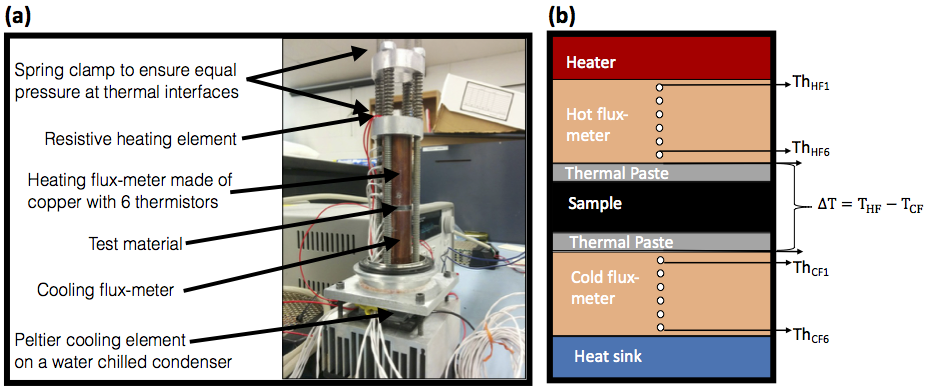
|
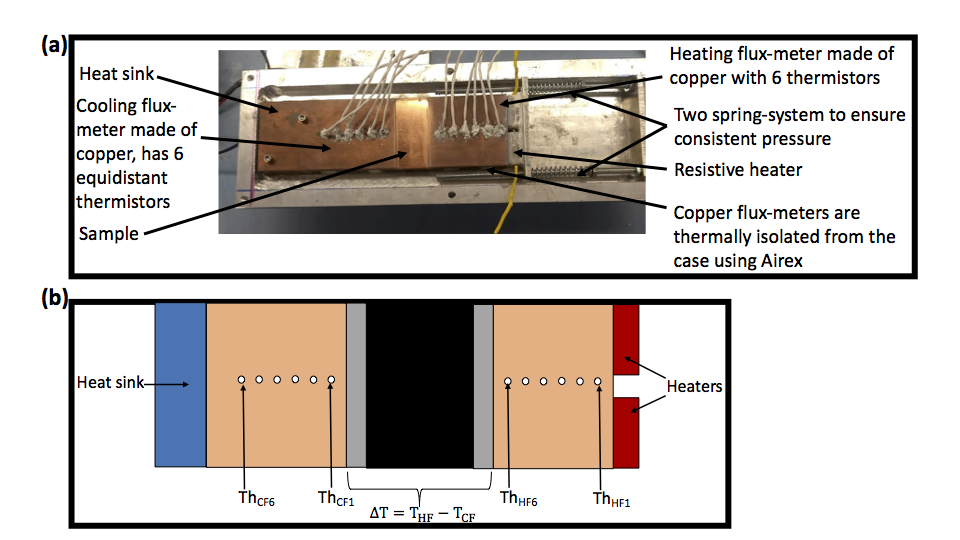
|
The through-plane conductivity apparatus shown in Fig. 1 has been used to measure thermal conductivities of carbon fiber, thermal greases and thermal adhesives. A typical measurement requires 4 or more samples of the material to eliminate the interface resistance between the flux-meters and the samples. For carbon fiber, each sample has to be a cylindrical disc of 1" diameter. The samples are required to be of maximally varying thicknesses, from 1 mm to 3 mm. For thermal interface materials, such as greases and adhesives, they are applied between 1" diameter sapphire discs to achieve very precise thicknesses between 70 and 200 um.
The in-plane conductivity apparatus shown in Fig. 2 has been used to measure thermal conductivities of carbon fiber. A typical measurement requires 4 or more samples of the material. If we define length to be the direction in which we measure thermal conductivity, we need samples of width = 50.0 mm, thickness = 4.0 mm. For carbon fiber samples where we know thermal conductivity along the length will be O(100) W/mK, we recommend sample lengths in the range from 15 to 60 mm. For samples where we know it will be O(10) W/mK, we recommend sample lengths in the range from 5 to 20 mm. If samples are to be shipped to Purdue, it is of paramount importance to protect the edges from chipping.
Carbon Fiber Composites
K13C2U / EX1515
This is K13C2U fiber from Mitsubishi Chemical Corporation in EX1515 resin from Toray Advanced Composites. It is obtained in pre-preg form. The fiber has k = 600 W/mK, and the resin has k = 0.17 W/mK.
The following are measurements of the material after lamination, assuming infinite thickness. Unidirectional measurements isolate the effective thermal conductivity of a single ply within a laminated bulk. These may be used to inform composite simulations to engineer special layup configurations for optimal thermal properties in desired directions. Cross-ply measurements measure the effective conductivity of the bulk.
Unidirectional Layup
| Layup and Curing | Direction | Theoretical Expectation | Measurement at 0 rad | Measurement at 1.5 Grad |
|---|---|---|---|---|
| [0/0/0... ], 4 bar | kxx | 318 W/mK | 335 ± 28 W/mK (INPL11) | |
| kyy | 0.53 W/mK | 6.6 ± 1.1 W/mK (INPL12) | ||
| kzz | 0.53 W/mK | 1.18 ± 0.15 W/mK (TC5) | ||
| [0/0/0... ], 10 bar | kzz | 1.36 ± 0.08 W/mK (TC20) | ||
| [0/0/0... ], 20 bar | kzz | 2.21 ± 0.31 W/mK (TC16) |
Cross-ply Layup
| Layup and Curing | Direction | Theoretical Expectation | Measurement at 0 rad | Measurement after Irradiation |
|---|---|---|---|---|
| [0/90/0... ], 4 bar | kxx, yy | 182 ± 14 W/mK (INPL13) | ||
| kzz | 1.27 ± 0.06 W/mK (TC3) | 1.40 ± 0.06 W/mK (TC3_Irradiated to 90 Mrad) | ||
| [0/90/0... ], 10 bar | kxy | 243 ± 17 W/mK (INPL16) | ||
| kzz | 2.18 ± 0.11 W/mK (TC19) | 2.33 ± 0.12 W/mK (TC19_Irradiated to 1.5 Grad) | ||
| [0/90/0... ], 20 bar | kxy | 236 ± 15 W/mK (INPL17) | ||
| kzz | 2.22 ± 0.15 W/mK (TC18) | 2.13 ± 0.20 W/mK (TC18_Irradiated to 1.5 Grad) |
With Dopants & Pressure
| Dopants, Layup, Curing | Direction | Theoretical Expectation | Measurement at 0 rad | Measurement at 1.5 Grad |
|---|---|---|---|---|
| [0/0/0], 4 bar | kzz | 0.53 W/mK | 1.09 ± 0.15 W/mK (TC5) | |
| 1.67% Graphite, [0/0/0], 4 bar | kzz | 1.40 ± 0.11 W/mK (TC14) | ||
| 10% Graphite, [0/90/0], 20 bar | kzz | 2.59 ± 0.12 W/mK (TC15) | 2.68 ± 0.10 W/mK (TC15_Irradiated) | |
| 10% Diamond Dust (20 um), [0/90/0], 4 bar | kzz | 1.85 ± 0.06 W/mK (TC22) |
K13D2U / EX1515
This is K13D2U fiber from Mitsubishi Chemical Corporation in EX1515 resin from Toray Advanced Composites. It is also obtained in pre-preg form. The fiber has k = 800 W/mK, and the resin has k = 0.17 W/mK. Cured at 4 bar, fiber volume fraction is 51.6%. Cured at 20 bar, it is 74.5%.
Unidirectional Layup
| Layup and Curing | Direction | Theoretical Expectation | Measurement at 0 rad |
|---|---|---|---|
| [0/0/0... ], 4 bar | kxx | 410 W/mK | 376 ± 31 W/mK (INPL9) |
| kyy | 7.5 ± 4.4 W/mK (INPL10) | ||
| kzz | 1.44 ± 0.24 W/mK (TC6) | ||
| [0/0/0... ], 7 bar | kxx | 437 ± 26 W/mK (INPL25) | |
| kyy | (INPL26) | ||
| kzz | 1.39 ± 0.10 (TC29) | ||
| [0/0/0... ], 10 bar | kzz | ||
| [0/0/0... ], 20 bar | kzz | 2.79 ± 0.46 W/mK (TC17) |
Cross-ply Layup
| Layup and Curing | Direction | Theoretical Expectation | Measurement at 0 rad | Measurement at 1.5 Grad |
|---|---|---|---|---|
| [0/90/0... ], 4 bar | kxx, yy | 210 ± 7 W/mK (INPL24) | ||
| kzz | 1.36 ± 0.04 W/mK (TC21) | 1.41 ± 0.05 W/mK (TC21_Irradiated) | ||
| [0/90/0... ], 7 bar | kxx, yy | 239 ± 9 W/mK (INPL23) | ||
| kzz | 1.5 ± 0.1 W/mK (TC28) | |||
| [0/90/0... ], 10 bar | kzz | |||
| [0/90/0... ], 20 bar | kzz | 4.0 ± 0.6 W/mK (TC8) |
With Dopants & Pressure
| Dopants, Layup, Curing | Direction | Theoretical Expectation | Measurement at 0 rad | Measurement at 1.5 Grad |
|---|---|---|---|---|
| 10% Graphite, [0/90/0], 7 bar | kzz | 2.17 ± 0.10 W/mK (TC23) 1.77 ± 0.13 W/mK (TC27) |
2.50 ± 0.17 W/mK (TC23 Irradiated to 1.5 Grad) | |
| kxx, kyy | 182 ± 7 W/mK (INPL21) 206 ± 7 W/mK (INPL22) |
158 ± 8 W/mK (INPL21 Irradiated to 1.5 Grad) |
Thermal Interface Materials
Moresco + Diamonds
This will be our TIM between the modules and carbon fiber Dee. Moresco RG-42R-1 is a low viscosity polyphenyl ether that is used as a grease. It is radiation resistant up to 1.1 Grad. We dope it with lapidiary diamond dust of 20 um average diameter at varying concentrations and measure the thermal conductivity of the resulting mixtures.
| Diamond 20 um Concentration by Weight | Measurement at 0 rad | Measurement at 1.5 Grad |
|---|---|---|
| 0% | 0.20 ± 0.02 W/mK (SAND18) | |
| 33% | 0.33 ± 0.03 W/mK (SAND19) | |
| 70% | 0.90 ± 0.08 W/mK (SAND23) | Sample irradiated: 1.03 ± 0.09 W/mK (SAND23_Irradiated), Material irradiated: 0.88 ± 0.07 W/mK (SAND31) |
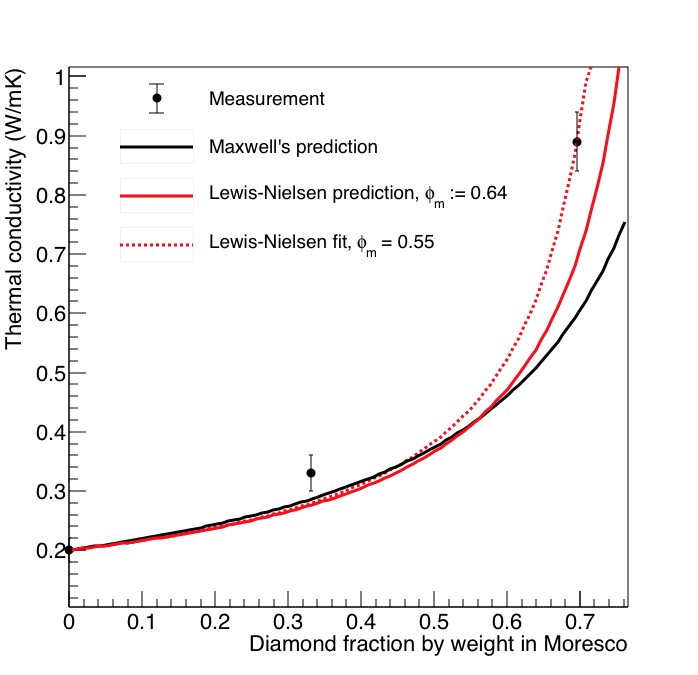
Loctite EA9396 + Diamonds
This will be our TIM adhesive between the cooling pipe and carbon foam. Loctite EA9396 is a two-part mixture that when cured does not compromise structural integrity up to 1.1 Grad. We dope it with lapidiary diamond dust of 20 um average diameter at varying concentrations and measure the thermal conductivity of the resulting mixtures.
| Diamond 20 um Concentration by Weight | Measurement at 0 rad | Measurement at 1.5 Grad |
|---|---|---|
| 0% | 0.34 ± 0.02 W/mK (SAND27) | |
| 30% | 0.44 ± 0.02 W/mK (SAND28) | |
| 50% | 0.74 ± 0.02 W/mK (SAND30) | |
| 70% | 1.28 ± 0.06 W/mK (SAND29) | 1.14 ± 0.09 W/mK (SAND29_Irradiated) |
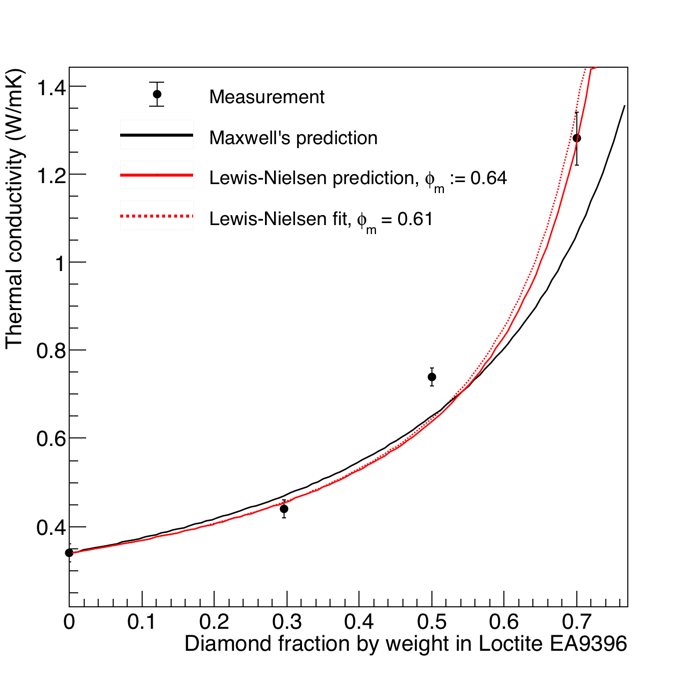
Araldite 2011 + Diamonds
This is a secondary candidate for the TIM adhesive between the cooling pipe and carbon foam. Araldite 2011 is a two-part mixture that rapidly cures within 1 hour when cured and does not compromise structural integrity up to 1.1 Grad. We dope Version 3 of Araldite 2011 with lapidiary diamond dust of 20 um average diameter at varying concentrations and measure the thermal conductivity of the resulting mixtures.
| Diamond 20 um Concentration by Weight | Measurement |
|---|---|
| 0% | 0.25 ± 0.01 W/mK (SAND24) |
| 30% | 0.33 ± 0.01 W/mK (SAND25) |
| 50% | 0.53 ± 0.03 W/mK (SAND26) |
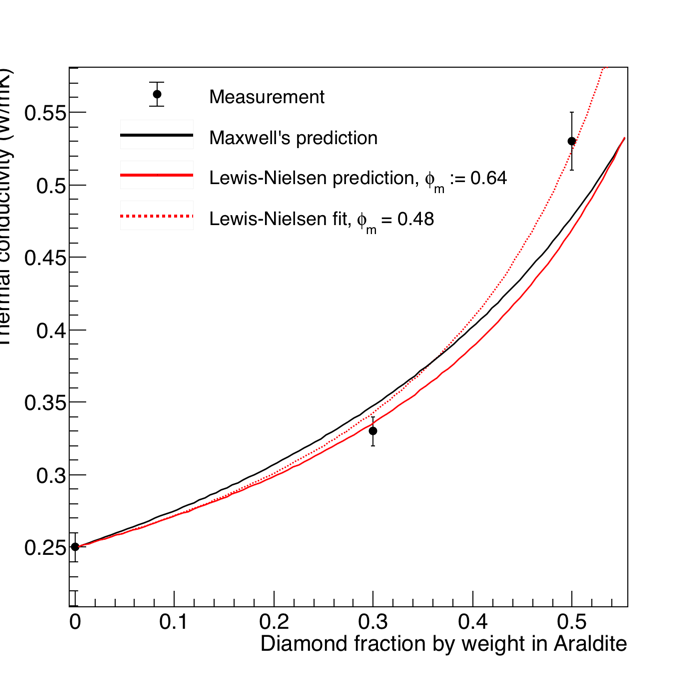
Carbon Foam
This is the carbon foam used in the Dee.
| Material Details | Manufacturer Datasheet | Measurement |
|---|---|---|
| Allcomp / Lockheed Martin, K9 densified, graphitized, Hi-K carbon foam. 130 PPI. SN 6, 10th Lot. (January, 2018) | 21.59 W/mK | 39 ± 7 W/mK |
Latest News
- Latest CMS News
- Observation of tt Entanglement
- DOE CMS upgrade award
- AirForce Phase III award
- DOE awards AI grant
- CMS Gold award
- Enormous Carbon Fiber prototype
- CMS upgrades funded
- Ramdas Award 2019
- New physics ?
- Summer 2018 UG exchange
- CMS phase II pixel upgrade workshop @Purdue
- Huffington Post: A new inner detector installed for CERN CMS experiment
- All News